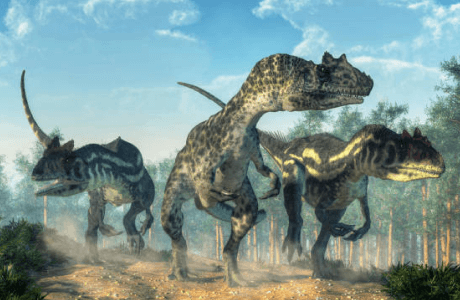Allosaurus

An Allosaurus trots through the forest until it spies a young Stegosaurus—one of this dino’s favorite meals. Running on two feet, the carnivore sprints about 21 miles an hour, about as fast as a car driving through a neighborhood. With eight-inch-long claws, it grabs Stegosaurus and chomps down with 70 sharp, thick teeth. Lunch is served.
Deadly carnivore
Experts aren’t sure if Allosaurus always hunted live prey—including giant plant-eaters like Apatosaurus—or if it sometimes scavenged dead or dying animals. Either way, Allosaurus was built to eat meat. Recent research on dino skulls found that Allosaurus could open its jaw so wide that it might’ve sometimes slashed its toothy upper jaw at prey, like a sharp knife. Then once it was time to grab a bite, Allosaurus likely ripped off pieces of meat by yanking its head backward, similar to how falcons and other raptors dine. Paleontologists have even found an Allosaurus bite mark on the neck plate of a Stegosaurus
Allosaurus lived about 145 million years ago, during the Jurassic period. Part of the theropod family—a group of dinosaurs that ran on two feet—this dino could grow up to 40 feet from head to tail, about the size of Tyrannosaurus rex (though most Allosaurus fossils are about 28 feet long). But T. rex, which lived about 76 million years later, had puny arms compared to Allosaurus’ forelimbs: Experts think it used its strong arms and clawed hands to hold struggling prey.
Strange Repile
The name Allosaurus comes from Greek words meaning “strange reptile.” Why? When the fossils were first discovered in the 1870s, the small bones forming the backbone were shaped like hourglasses, and that was different from other dinosaur spines that scientists had examined at that time.
Fossils of Allosaurus have been found in Colorado, Utah (where it’s the state fossil), Wyoming, and Montana, as well as in the countries of Tanzania and Germany.
